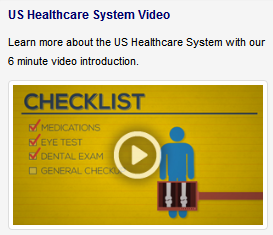I’m Scared to Talk About My Mental Health Issues, What Can I Do?
April 17th, 2017 by Yessica Prato
Imagine waking up one day and not knowing why you feel tired even after a good night sleep. Suddenly, simple tasks like showering, getting ready for classes, or leaving your room seem to require an incredible amount of strength. This could be signs of a mental health condition. As an international student, many factors can affect your mental health. Not only are you exposed to a completely different culture and you are far away from home, but you also have to be mindful of your studies.
In the United States, mental health conditions have become an important health issue for society. According to the National Institute of Mental Health, 1 in 5 adults in the US experiences mental health illnesses. Unfortunately, in many other countries, mental health is very much tabooed and professional help may be limited. In some countries, seeking mental health assistance means embarrassing your family or even breaking up your personal relationships.
If you are scared to talk about your mental health issues, it is important to know that you are not alone in this journey. Mental health conditions are real ailments. There are many resources out there to assists you and treat any mental health illnesses. With this article we have 4 tips to help you prepare for the mental health conversation and what will come next.
Do some research
Ask yourself, “how am I feeling today?”. It may sound silly, but this question can give you an overview on your mental health. If you notice changes in your everyday routine like lack of sleep, loss of appetite, or loss of interest on things you loved to do before, it is time to have an honest conversation about your mental health. Read about mental health and familiarize yourself with terms like depression, anxiety, and cultural shock. Don’t try to self-diagnose, instead do try to educate yourself about mental health. This will make the next step easier.
Find a person you trust
Mental illness can be a hard subject to approach for anyone. Nevertheless, sharing how you feel is a great step in the right direction. This will help you feel like some of the weight is lifted off your shoulders. Choose a family member, friend, or counselor and tell them how you feel privately. Remember, school counseling services are safe places, and anything you tell a counselor is private and protected by privacy laws in the United States.
Check your campus resources
Many schools in the US offer counselling services for their students, and they are often free or offered at a low-cost. This is a great place to start if you don’t know where to go or who to contact. You can also go to your student health center and talk to a primary care physician about how you are feeling. They can recommend places off campus like psychologists or psychiatrists offices that could aid you during this time.
You are not alone!
As lonely as you may be feeling, it’s important to remember that a lot of students struggle during college. With the stress of classes and being away from home, it is okay not to feel well. Therefore, you will have to advocate for yourself because only you know how you feel. There are many resources like the National Suicide Prevention Lifeline. You can contact them at 1.800.2738255 and you can remain anonymous and talk to someone completely for free. In addition, you can join support groups on campus to help you with the difficulties of being in a different country.
The key here is to not give up on yourself. There are many people willing to help you and resources that you can use privately. Regardless of whether you have a mental health or substance use condition, you can overcome these issues and be successful in school. If you’d like to learn more about mental health, please visit our insurance explained section on mental health.
Travel Medical Insurance Plan Updated for 2017
April 3rd, 2017 by Ross Mason Good news! Our Travel Medical Insurance plan has been updated and upgraded for 2017. The enhancements to the product include:
Good news! Our Travel Medical Insurance plan has been updated and upgraded for 2017. The enhancements to the product include:
- New $2,000,000 policy maximum option
- Addition of chiropractor care to physical therapy benefit – $50/day
- Waive $50 Urgent Care Facility co-pay for those purchasing a $0 deductible plan
- Vantage America drug discount card for policies with U.S. as a destination
- No changes in rates!
The new plan changes went live on April 1st, and you can purchase and quote online to see the new options.
About the Travel Medical Insurance Plan
Available from 5 days up to 364 days for those traveling to the USA and for US Citizens, and for up to 365 days (with renewability up to 3 years) for those non-US Citizens who are not traveling to the USA. It covers a range of benefits including hospitalisation, doctors visits, prescription medications, emergency evacuation, repatriation, emergency reunion and more. You can find a full list of benefits available on our website.
The plan is ideal for students, and non-students who are looking for short to medium term travel medical insurance coverage covering a range of benefits. It is also an excellent plan for families, or dependents, and when both parents are insured on the plan you can include 2 children 9 and under for free!
If you have any questions the plan, or would like to receive a free quote – please do not hesitate to contact our team.
Medical Checklist Before You Travel to the USA
March 2nd, 2017 by Leah HammondStudying in the United States can be a once in a lifetime experience, but preparing for your time abroad can also be a stressful and overwhelming process. Between getting your visa processed, booking your plane ticket, preparing to start classes and setting up your living arrangements, there are many things to remember when planning for your time in the United States.
Taking care of your health before you leave your home country is one of the most important things to remember, but with so many things to do, it’s not always a priority. There are some simple things you can do before arriving in the US to make your life much easier, and with some advanced planning, you can prevent having to pay out of pocket for medical expenses that are not covered under your international student insurance plan.
Watch our US Healthcare System overview video
To help you get started, follow this medical checklist before you travel to the USA to ensure a stress free time abroad!
Before traveling to the United States, it is important to go to your doctor for a general check up to make sure that you are in good health and that your immunizations are up to date. Most schools in the US require specific immunizations before you can enroll in classes, and it is usually more cost effective to take care of these before you have departed your home country. The most common vaccinations that most colleges and universities require international students to have include the MMR vaccine (Measles, Mumps, and Rubella), as well as a Tuberculosis Screening.
Get a quote for the Student Secure Elite which offers coverage for vaccinations
Remember that each school is different, so you will want to check with your school to ensure that you are meeting the necessary requirements!
Routine dental care in the United States can be very expensive, and is typically not covered under your international health insurance plan. Before coming to the US, take the time to go to your dentist for an annual cleaning.
Some international health insurance plans, like the Student Secure plan, will offer limited coverage for dental treatment due to accident or to alleviate pain, but standard routine cleanings and procedures are normally excluded from coverage and would be an out of pocket expense for you in the US.
Eye examinations are also typically not covered under international health insurance plans, so we would suggest getting your vision checked before your arrival in the United States. This is especially important if you have prescription glasses or if you wear contacts. You will want to make sure that you have at least one pair of your prescription glasses with you (a back-up pair is always a good idea!), and at least a full year’s supply of contacts.
If you are planning to stay abroad for at least a year and would like to explore the pricing of a plan that could cover a vision exam and some money to get a replacement pair of glasses check our Global Medical plan which gives you the option to purchase additional coverage for Vision and Dental.
Most international health insurance plans do not cover pre-existing conditions right away (if at all). This means that any medications that you are prescribed before the start date of your insurance plan will likely not be covered! Before leaving for the United States, you should ask your doctor to prescribe a longer supply of your medication to take with you while you are in the US.
As mentioned, most international health insurance plans do not include coverage for pre-existing conditions. Just like with prescription medication, if you know of any big procedures, like a surgery, that you need to have prior to the start date of your insurance plan, it would more than likely fall under the category of a pre-existing condition and would not be covered. Any major procedures should be taken care of before you leave your home country, as major medical treatment can be very expensive in the United States.
Learn more about coverage for pre-existing conditions here

Following these steps will make your time in the United States much less stressful, as you won’t have to worry about potentially paying for uncovered medical expenses. We know that health insurance in the United States can seem complicated, which is why we’ve created a short video overview to help you navigate the US Healthcare system as an international student.
Top Questions International Students Have About the ACA
January 10th, 2017 by Jennifer Frankel Even if you now know what the ACA stands for (Affordable Care Act), you still might be filled with questions about what it means for you as an international student. In today’s blog, we are going to explore the top questions international students have about the ACA.
Even if you now know what the ACA stands for (Affordable Care Act), you still might be filled with questions about what it means for you as an international student. In today’s blog, we are going to explore the top questions international students have about the ACA.
1. What is the Affordable Care Act?
The Affordable Care Act is legislation that essentially overhauled the US health insurance and health care systems. It required US carriers to offer plans to US citizens/permanent residents that have “essential health benefits”. These benefits are often costly causing insurance under the ACA to soar as high as 25%. With the goal to insure every US citizen and permanent residents, the IRS institutes a tax penalty for those who do not have a plan that is ACA compliant.
2. How does the ACA impact international students?
If you are an international student in the US, chances are it won’t affect you at all. If you are an international student on a F1 or J1 visa and have been in the US for less than 5 calendar years, then you are exempt from the ACA and can choose any plan you’d like (as determined by you and your school). If you have been in the US for longer than 5 calendar years, then you’ll have to look at your taxes. If you are a non-resident alien for tax purposes, then you are exempt from the Affordable Care Act and it’s up to both you and your school to determine what insurance plan you will have. If you are a resident alien for tax purposes, you will be required to purchase an ACA compliant plan, otherwise you’ll be subject to the tax penalty.
3. What’s the difference between a non-ACA and ACA plan?
ACA plans are required to have “essential health benefits” which provides coverage for:
- Ambulatory patient services (outpatient care you get without being admitted to a hospital)
- Emergency services
- Hospitalization
- Pregnancy, maternity, and newborn care
- Mental health and substance use disorder services, including behavioral health treatment
- Prescription drugs
- Rehabilitative and habilitative services and devices
- Laboratory services
- Preventive and wellness services and chronic disease management
- Pediatric services, including oral and vision care (but adult dental and vision coverage aren’t essential health benefits)
- 100% Birth control coverage
- Breastfeeding coverage
In addition to these benefits, plan must offer unlimited coverage and cover pre-existing conditions from day 1. Because these plans on the exchanges are extremely comprehensive they tend to have high deductibles oftentimes starting at $1,000, and they also have a high price tag as well. Most international student plans are not ACA compliant so they will often have a maximum coverage (often ranging from $100,000 to $500,000), have a waiting period before pre-existing conditions are covered, and are designed to cover new accidents and illnesses that occur on the plan. They typically have low deductibles often ranging from $25 to $250, and also are low in cost (often less than $1,000).
4. Which plan is right for me?
For most international students, the need is quite simple: an affordable plan that covers accidents and illnesses that could happen while studying in the US. If you aren’t sure which option is better for you, you’ll want to consider:
-
- How much are you looking to spend on your insurance plan (premium)?
- How much can you afford to pay out of pocket when seeking care (deductible/coinsurance/copay)?
- Do you have a pre-existing condition that will require continuous care beyond the medications you bring from home?
Just looking at these questions will help narrow down your options as to whether an ACA or non-ACA compliant plan would be best suited for you.
5. Where can I get more information on the ACA?
If you have more questions on the ACA, please be sure to check out our article on the Impact of the ACA on international students as well as this article which talks more specifically on international students and the ACA. You can also go directly to the source and learn about how it affects you at Healthcare. gov.
If you are trying to decide on your options, it can be quite complicated. Be sure to contact our Customer Service Representatives with any questions you have, as we are always happy to help guide you so that you can make the best decision regarding your health insurance needs. You may also want to keep in mind that this could all change with the new Trump administration. As changes are made, we will of course keep you updated.
Two Insurance Plans: A Good or Bad Idea?
December 15th, 2016 by Bryanna DavisMore is always better, right? When it comes to the number of insurance plans you have, that’s not always the case. If you’re considering buying two (or more) health insurance plans here are a few things that you need to keep in mind.
Why consider buying two insurance plans?
A few common scenarios as to why international students and scholars feel the need to buy more than one plan include the following:
1. A plan was already purchased but will not meet all federal or school requirements.
2. You don’t think the plan options available to you have enough coverage.
3. The plan that you have doesn’t cover a condition that just developed.
Let’s dive into each of these situations in greater detail.
- A plan was already purchased but will not meet all federal or school requirements.
First and foremost, check the cancellation policy of the plan you already have if it doesn’t meet your needs. Some plans will allow you to even cancel for a full refund if you do so before the start date, so check the cancellation policy and check it as soon as possible. If cancelling your plan isn’t an option, then exploring other plans that specifically cover the benefit you need is. However, it’s important that you do not buy two primary plans, or two secondary plans (plans that are run after the primary) that have the same coverage- this could cause problems down the road if you need to file a claim. For example, perhaps you’re trying to meet the federal J visa insurance requirements and your current plan does not have emergency medical evacuation or repatriation of remains coverage. Since your current plan will cover your other medical needs (like hospitalization) you’ll want to find a supplemental, stand-alone plan to cover the evacuation and repatriation. - You don’t think the plan options available to you have enough coverage.
If you find a plan that you like and are wondering if you can buy two of them so you can double the coverage- unfortunately not. The same is true if you find two different primary or two different secondary plans that you like and want to buy. If you do find two plans that you like it’s fine to purchase them if one plan is a primary plan (meaning it’s the plan that the provider will run first), and the other plan is a secondary plan (meaning it’s the plan that the provider will run if there are any remaining expenses). - The plan that you have doesn’t cover a condition that just developed.
If you already have a condition, whether officially diagnosed or just symptoms of, it’s a pre-existing condition. This means if you buy a plan specifically to cover a pre-existing condition you need to make sure it covers pre-existing without a waiting period. Keep in mind that it will be difficult to find a plan that covers pre-existing conditions without a waiting period and plans that do will be very expensive. It’s best to buy a plan that can cover potential items (like a sports injury or a pregnancy) before they happen.
If needed, having two insurance plans is an available option if one plan is a primary and the other a secondary. However, it’s best to find one solid plan that has the potential to cover what you need.
Now Announcing the 2016 Travel Video Contest Winners!
November 23rd, 2016 by Sutherland Beever The votes are in and it’s about time that you find out who wins, right? Grab a bag of popcorn and find a comfy chair, because we are now announcing the 2016 Travel Video Contest winners!
The votes are in and it’s about time that you find out who wins, right? Grab a bag of popcorn and find a comfy chair, because we are now announcing the 2016 Travel Video Contest winners!
After spending nearly 1,000 hours watching video after video submission, the InternationalStudent.com team and panel of judges have finally decided who goes home with the cash.
To save you some time, we’ve prepared a snapshot of the overall contest winners, but don’t forget to give the other entries and finalists a glance too. You can view all the submissions to this year’s contest here.
A huge round of applause is owed to the grand prize winner of the 2016 Travel Video Contest, Mariana Osorio, for her submission, “This Magic World.” As a student growing up in one of Mexico’s poorest states, she tells an inspiring story of her life through song – and an original song at that! If you are going to watch any of this year’s video submissions, be sure to check out this songbird. Perhaps best of all, in addition to being $4,000 richer, Mariana is going to be a regular blogger on the InternationalStudent.com, so we can periodically check in on her travels through the Study in the USA blog.
Needing a bit of inspiration in your life? This year’s second place video is called “Dream, Believe, and Make It Happen!” and is sure to motivate you! Siti Fatimah of Indonesia spent much of her childhood as an orphan, and her story is all about overcoming impossible odds to achieve her dream of studying abroad and eventually becoming a professional obstetrician. We’re wishing Siti the best of luck and congratulations on earning a $500 prize!
Rounding out the top three finalists is a black and white submission called “The Urban Archi,” by Michael de Beer. Fueled by crime and discrimination in his South African city, Michael knew from an early age that he wanted to become an architect and eventually help his city gradually urbanize. His thoughtful submission has earned him a $250 prize.
And last, but certainly not least, this year’s Viewers’ Choice winner! Chosen by popular vote, this year’s recipient is “A Couple of MBAA’s” by Carlos Roberto Gonzalez Meyer. If you are in the mood for a good laugh, be sure to watch Carlos and his girlfriend act out their past and future travel plans in the video that earned them a whopping $1,000 prize.
We’re sending a huge shout out to everyone who submitted a video entry. The competition was tough, but the contest will be back next year! Start your preparations by checking out each of the winning video entries from the 2016 contest and keep those cameras recording.
It’s That Time Again: Now Announcing the 2016 Travel Video Contest!
September 6th, 2016 by Sutherland BeeverGet your video cameras ready and your creative juices flowing because now is your chance to earn $4,000!
Let’s be honest, writing, shooting and editing an amazing video about your travel experiences doesn’t happen overnight, but with a bit of hard work and a dash of creativity, your video submission could earn you the title of Grand Prize winner!
Here’s What You Need to know for your Shot at the Grand Prize:
InternationalStudent.com hosts a Travel Video Contest every year for students to let their imaginations run wild and become real life filmmakers, tasked with creating their own travel-themed videos. The rules are pretty straight forward: current international students need to create a video (less than 5 minutes long) about a trip that they want to take in the future, and students who have yet to study abroad should create a video about the experiences and knowledge they will gain as an international student.
Create a film to move us or inspire us – the choice is yours. After all, you are the filmmaker.
Here are Three Insider Tips to get you Started:
- Be Yourself – It sounds easy, right? The Travel Video Contest is all about telling a story as unique as you are, so let your personality shine throughout your video.
- Don’t Underestimate the Power of Editing – You only have 5 minutes to tell your story, so every second counts! After you’ve gotten most of your video finished, show it to a few friends or family members for their feedback. If your story lulls in places or if some pieces don’t quite fit, take it out! The contest rules state that there’s nothing wrong with your video being less than 5 minutes in length, it just can’t be over.
- Quality is Everything – This should come without saying, but the most emotionally driven video submission in the world won’t amount to much if we can’t hear the dialog. Feel free to shoot the video with any camera you would like, but it’s important that the quality of your video is up to par with past winners. Clear, crisp voices, visuals and music is key!
Dates to Remember:
- Submission Deadline: October 14, 2016
- Finalists Announced: The week of November 7, 2016
- Winners announced: November 18, 2016
May the best video win!
I Don’t Have Insurance, But Have Medical Bills To Pay!
August 1st, 2016 by Sutherland BeeverYou’re young. You’re healthy. And then out of nowhere, you’re faced with a medical emergency, spend some time in the hospital, and are now forced with astronomical medical bills to pay.

What Now?
First things first: don’t get discouraged. It would be easy to stash away your medical bills in a drawer or sit them far back on a shelf to collect dust, but the fact is that these bills won’t disappear. And most importantly, you are much, much more likely to receive financial assistance if you work with the provider before the bill is sent to a collection agency. Luckily, there are many steps that you can take to help your situation and potentially even lower your outstanding bills!
It’s important to keep in mind that hospitals are well aware that paying medical bills without insurance can be extremely difficult, so generally they will work with you to find a reasonable way to help you pay off your debt, and can even help lower the overall amount that you owe.Of course, all of these great things can’t happen if you don’t ask. This is where a letter of hardship can help save the day.
If you genuinely have no means to pay the medical bills that you now owe, it would be in your best interest to write a letter to the provider letting them know of your situation and your inability to pay.
![]() Be sure to include the fact that you are an international student, unfamiliar with the US healthcare system, and any additional information that could help your case.
Be sure to include the fact that you are an international student, unfamiliar with the US healthcare system, and any additional information that could help your case.
Depending on the amount owed and your personal situation, a provider may write off a good portion, specific services, or even your entire bill! If you don’t receive a response to your letter within a few weeks, be sure to follow-up with a phone call to reconfirm your situation. Of course, this isn’t a guarantee, but it’s worth your time to try!
This step can be time-consuming, but it’s worth every moment. It’s especially important to check your bills if you spent a long period in the hospital or had a complicated procedure, as it is possible that a portion of the bill that you’ve received isn’t right. The most common errors tend to be that you’ve been billed for services or medications that you didn’t actually receive. Take into consideration the time that you stayed in the hospital as well. Sometimes if you’ve checked out in the morning you could have been charged for a full day, adding thousands of dollars to your bill.
It’s important to note that the US healthcare system is set up for individuals to have health insurance. Without insurance, you will be paying a substantial amount more for the medical treatment that you receive, compared to someone who does have insurance and receives deep in-network discounts. If a letter of distress to the provider doesn’t lower your bill enough, or at all, the next step is to try to negotiate.
As mentioned before, providers want to get paid – even if they don’t receive as much as they’ve billed you for, so you likely have some room to negotiate at least a small portion of the amount that you owe. In order to do so, it’s important that you are armed with information to help your cause. Check nearby hospitals to discern how much they would have charged for the procedure that you had. If the provider that you visited is charging grossly more, this could be a good negotiating point!
Regardless if you were able to negotiate a lower overall balance or not, providers know that a huge medical bill broken down into small, manageable payments is much more likely to be paid off, so call the provider and ask if they can set up an interest-free payment plan. It’s important to speak to the right person and let them know of your situation, and that you’re trying to pay off your debt but lack the income to do so right away.
The bottom line is that medical emergencies are never planned, but are always costly. Luckily for you, there are countless resources available to help you negotiate and even lower your bill, as well as set up payment plans. Don’t let your bills overwhelm you. As dim as the situation may seem, you can work your way out of it!
Avoid these inconvenient situations by purchasing a health insurance plan in advance, we offer different options to meet your needs.
Check our student health insurance plan options:

Student Health Insurance
The Student Secure plan provides international student health insurance in the USA and around the world, offering 4 plan levels; Smart, Budget, Select, and Elite. With comprehensive benefits and simple monthly payment options.

The Student Health Advantage provides international student health insurance to both international and study abroad students who are studying outside of their residence country. The plan is available for as little as one month, and as long as you purchase 3 months of coverage initially, the plan can be extended for up to 12 months and then renewed for up to 5 years in total.
You can always contact us if you are not sure of which is the right insurance plan for you.
Individual or Group Insurance – What is Right for My Group?
July 11th, 2016 by Jennifer Frankel Many schools and organizations come to us trying to figure out how to best manage their insurance plan. Deciding whether an individual or group insurance plan is best for your students can be difficult, and will depend on your process, how much control (and how involved) you want over the insurance, ease of administration, and various other factors. Your answers to these, and other questions, will help you make the final decision as to whether a group or individual insurance plan would be more suitable.
Many schools and organizations come to us trying to figure out how to best manage their insurance plan. Deciding whether an individual or group insurance plan is best for your students can be difficult, and will depend on your process, how much control (and how involved) you want over the insurance, ease of administration, and various other factors. Your answers to these, and other questions, will help you make the final decision as to whether a group or individual insurance plan would be more suitable.
This blog is designed to provide schools and organizations with an overview of the differences between a group or individual plan and will evaluate the main issues to help inform your decision about how to best implement your insurance plan.
1. Payment Method – The main difference between group and individual insurance plans are how the insurance premiums are paid and settled. With a group plan, the cost of insurance is covered by the school or group, typically through a monthly or one-time invoice. This allows the cost of the insurance plan to be built into the trip cost or student’s tuition. With an individual plan, on the other hand, the cost of the insurance plan is paid for by the participants directly, thereby relieving the school or organization from having to collect insurance premium and make payment.
Note: If students are paying monthly on an individual plan, it’s important to know that billing issues could arise where there could be a lapse of payment. The insurance will typically notify the student and provide a grace period to make the overdue charge. If payment is not received, however, the policy will end and you may not even know! To prevent this, it is suggested that students always pre-pay for the required period, or you institute a group plan to avoid this happening.
2. Benefits & Cost – Group insurance plans typically have richer benefits and are typically offered at a lower cost, since they are able to rely on the law of numbers and a random pool of participants to outweigh the risk. With this in mind, group insurance plans can often be customized to include coverage for maternity, pre-existing conditions, etc. in ways that individual plans cannot. This is because with individual plans, insurance carriers have to be wary of adverse selection, making sure that not only the people who are in need of the insurance, buy it, but those who don’t need it buy the plan as well. In some cases, group insurance plans are less costly as group discounts may be offered depending on the number of participants enrolled.
>>Learn more about important benefits to consider
3. Knowing Your Coverage – One of the advantages of having a group plan is that you know what coverage your participants have, and you are also familiar with the process to seek treatment, file a claim, and get help when necessary. You can make sure that the insurance benefits will be well designed to meet the needs of their international experience (i.e., include sports coverage, maternity, etc.), and don’t have to worry about students being enrolled on sub-par plans. With individual plans, you would not have this same control as students would be able to purchase the coverage they want, and benefits, claims processes, etc. could vary quite considerably. If you would like an individual plan for your students, here are the most common ways to manage this:
- Leaving students on their own
- Require minimum coverage
- Mandating one or more insurance options
>>Learn more about each option online in our Best Practice Guide
4. Duration of Coverage – Group plans allow the plan administrator to ensure all participants/students are covered for the exact coverage dates they need. Typically groups coincide the dates of coverage with their travel dates or with the academic term, making sure students are fully covered during their time abroad or while enrolled in their courses. On an individual plan, the participant is the one that selects the start and end date of their insurance, and while many schools and organizations require that students have coverage during a specified period of time, students may not always purchase the correct period of coverage. This can create extra administration, as you would need to check each participant’s coverage to make sure they have the correct coverage dates.
5. Account Management – Most group plans offer a higher level of customer service through a dedicated account manager who is assigned to help you every step of the way. This point person can assist with all aspects of your insurance plan so that things are quickly and easily resolved. If students are purchasing their coverage on their own, you might not have an account manager in this setup, as plans could be purchases from a wide variety of providers. You may, however, be able to establish a good relationship with one insurance company if you are referring all your students to purchase coverage there, so that could be something you could explore.>>Learn more about service and support options
When it comes to deciding whether an individual or group insurance plan is right for you, there is a lot to think about! If you are in the process of deciding how best to implement your insurance, please feel free to contact us directly as we’d be happy to walk you through the process and determine which option is best for you. You can also check out our Best Practices Guide which provides even more details about important considerations of your insurance plan.




